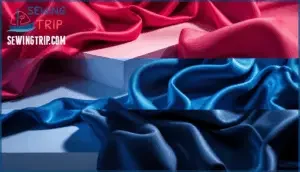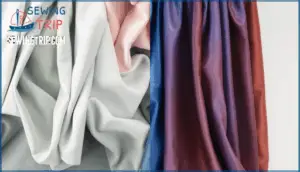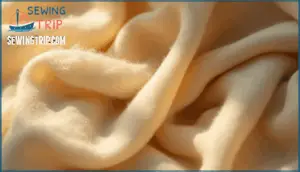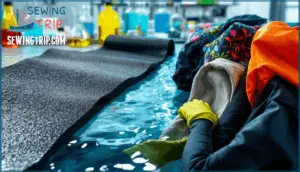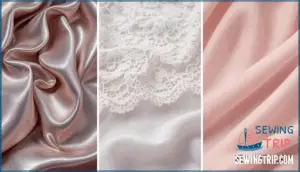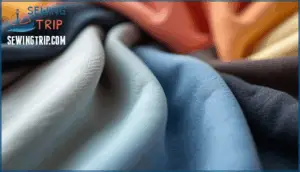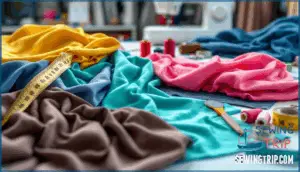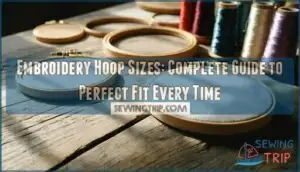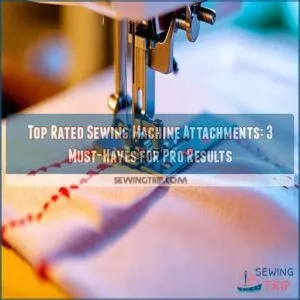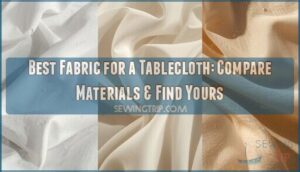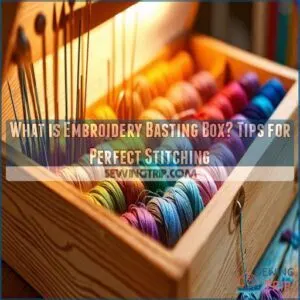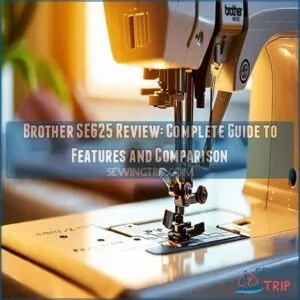This site is supported by our readers. We may earn a commission, at no cost to you, if you purchase through links.
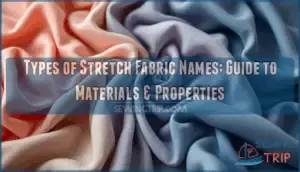 You’ll find stretch fabric names everywhere, from your gym leggings to your favorite dress, but the sheer number of options can feel overwhelming. Elastane, spandex, Lycra, nylon blends, cotton blends—each name signals different properties that affect how your fabric performs.
You’ll find stretch fabric names everywhere, from your gym leggings to your favorite dress, but the sheer number of options can feel overwhelming. Elastane, spandex, Lycra, nylon blends, cotton blends—each name signals different properties that affect how your fabric performs.
Understanding these names helps you choose materials that actually work for your projects instead of guessing at the fabric store.
This guide breaks down the most common stretch fabric types, explains what makes each one unique, and shows you how to pick the right material for whatever you’re making.
Table Of Contents
Key Takeaways
- Elastane, spandex, and Lycra are the same elastic fiber with different names—elastane is the generic term, spandex is the American name, and Lycra is DuPont’s brand—and all three can stretch up to 500% before snapping back to shape.
- The difference between 2-way and 4-way stretch matters for your project because 2-way stretch moves in only one direction (making it suitable for casual wear), while 4-way stretch moves both horizontally and vertically (which you need for activewear and performance gear).
- Natural stretch fabrics like merino wool and bamboo offer built-in elasticity with sustainability benefits, as wool stretches up to 30% and bounces back naturally while bamboo grows without pesticides and resists pilling through multiple washes.
- Synthetic stretch fabrics create serious environmental problems by releasing up to 700,000 microplastic beads per wash and persisting in landfills for over 200 years, but you can choose recycled synthetics, biodegradable elastane, or organic alternatives to reduce this impact.
What is Stretch Fabric?
Stretch fabric is cloth woven or knit with elastic fibers that let it expand and return to its original shape. You’ll find it in everything from yoga pants to swimsuits because it moves with your body instead of restricting it.
Let’s look at what makes stretch fabric work, how it came to be, and the methods used to create it.
Definition and Key Features
Stretch fabric is any textile that contains elastic fibers—like elastane, spandex, or lycra—that let it pull and snap back without losing its shape.
This material elasticity comes from the fabric composition, which commonly blends synthetic elastic fibers with other materials like cotton or polyester.
The performance benefits include comfort and flexibility, while stretch levels vary depending on the material blends used in construction.
History and Development
The elastic revolution kicked off in 1958 when chemist Joseph Shivers invented elastane at DuPont, forever changing how we think about comfort in clothing. Early applications focused on foundation garments and hosiery before expanding into everyday wear. Here’s how stretch fabric evolved:
- 1950s-60s: Elastane invention sparked the spandex naming debate and revolutionized textile production
- 1970s-80s: Athletic wear adopted stretch fabric composition for performance benefits
- Today: Fabric evolution continues with sustainable weaving methods and creative fabric development
This history of fabric development shows how types of stretchy fabrics transformed from specialty textiles into wardrobe essentials.
How Stretch Fabrics Are Made
You might wonder how manufacturers turn ordinary fibers into stretchy materials that snap back to shape after every movement. The textile industry uses several fabric construction methods to create synthetic fibers with elasticity. Here’s how it works:
| Production Stage | Method | Result |
|---|---|---|
| Fiber Spinning | Melting polymers into strands | Creates elastic threads |
| Knitting Process | Interlocking loops for flexibility | Adds natural stretch |
| Weaving Techniques | Integrating elastic fibers | Produces stable stretch |
| Fabric Finishing | Chemical treatments and heat | Locks in recovery |
This fabric composition and production process transforms basic synthetic fiber into materials that move with you.
Common Types of Stretch Fabrics
When you’re shopping for stretch fabric, the options can feel overwhelming. The good news is that most stretch fabrics fall into a few main categories based on their fiber content and construction.
Let’s break down the most common types you’ll encounter so you can choose the right material for your project.
Elastane, Spandex, and Lycra
Here’s the thing about elastane, spandex, and Lycra—they’re actually the same stretchy fiber with different names. Elastane is the generic term, while spandex is what Americans call it. Lycra is just the brand name from DuPont.
All three offer exceptional stretch and recovery, expanding up to 500% before snapping back. You’ll find them blended with cotton, nylon, or polyester to add flexibility without sacrificing the base fabric’s breathability or strength.
Nylon Spandex and Polyester Spandex
When you need serious performance from your activewear, nylon spandex and polyester spandex are the workhorses that won’t quit. Nylon spandex offers exceptional stretch and softness, making it perfect for swimwear and athletic wear. Polyester spandex wins on durability and moisture-wicking, holding up better in outdoor gear.
Both types of stretch fabric blend easily with other materials, though polyester costs less and resists fading better than nylon.
Cotton Spandex and Rayon Spandex
Cotton spandex and rayon spandex bring the comfort of natural fibers together with stretch you can actually feel. Cotton spandex gives you breathability and that soft, familiar feel you love in casual wear. Rayon spandex drapes beautifully and works perfectly for flowy dresses and tops.
Here’s what sets these fabric blends apart:
- Comfort factors: Cotton spandex keeps you cooler while rayon spandex feels silkier against your skin
- Care differences: Cotton spandex withstands machine washing better than delicate rayon spandex
- Cost comparison: Cotton spandex generally costs less than rayon spandex for most clothing applications
Natural Stretch Fabrics (Wool, Bamboo)
You’ll find stretch fabrics in nature too. Merino wool fibers stretch up to 30% of their original length and bounce back into shape thanks to their natural crimp. Bamboo fabric offers built-in elasticity and resists pilling even after multiple washes. Both deliver moisture-wicking and thermal regulation for year-round comfort.
Sustainable sourcing makes these natural fibers environmentally friendly choices—Australian wool production leads globally while bamboo grows without pesticides.
The market for bamboo clothing reached $1.3 billion in 2022 and keeps climbing as more people discover these durable alternatives. The industry is expected to see substantial market growth reaching $3 billion by 2032.
Neoprene and Specialized Synthetics
Neoprene sits at the forefront of synthetic stretch fabrics—it’s the material that transformed wetsuits and now powers high-performance activewear. This neoprene rubber delivers waterproof insulation and remarkable durability for extreme conditions.
Manufacturing innovations have expanded synthetic materials like stretch PVC into specialized applications, from compression garments to technical sportswear. These synthetic fibers resist chlorine and saltwater better than standard spandex, though you’ll pay more for their durability.
Specialty and Performance Stretch Fabrics
Beyond basic stretch fabrics, you’ll find specialized materials designed for specific looks and performance needs. These fabrics range from sheer and decorative to heavy-duty support materials.
Let’s explore the specialty options that can improve your next project.
Stretch Jersey and Mesh Fabrics
Jersey and mesh fabrics are the workhorses of the stretch fabric world—you’ll find them in everything from your favorite t-shirt to high-performance athletic gear. Here’s what makes each special:
- Jersey breathability comes from its knit construction, which creates natural stretch recovery and fabric opacity you can count on.
- Mesh ventilation uses openwork fabric design with micro-gaps that boost airflow during intense workouts.
- Stretch mesh combines the best of both—flexible knit fabrics with built-in cooling properties.
Power Mesh and Power Net
Power mesh and power net are the unsung heroes behind smooth silhouettes and comfortable support in everything from dancewear to shapewear. These durable stretch fabrics feature an open construction that offers breathability while maintaining firm control.
You’ll find power mesh in 2-way or 4-way stretch variations, perfect for lining garments or creating tummy panels. The fabric bounces back after wear and holds its shape through repeated washing.
Metallic, Foil, and Hologram Spandex
Metallic spandex delivers a smooth, solid finish that catches light beautifully while remaining easy to sew. Meanwhile, hologram spandex features reflective foiling bits fused onto nylon for eye-catching effects—though it comes with a higher price tag. Foil print spandex adds embossed accents but requires careful care since the foiling can flake with wear. Metallic spandex is also popular in compression fit athleticwear due to its supportive nature.
These performance costuming materials shine in dancewear and stage costumes:
- Metallic finishes offer high-quality sheen without sewing challenges
- Hologram effects create dramatic reflective properties under stage lights
- Foil print variations balance visual impact with affordability
- Foiling durability varies—metallic versions outlast printed alternatives
Choose based on your project’s budget and how much wear the garment will see.
Stretch Velvet and Panne Velvet
While metallic finishes grab attention with shine, stretch velvet brings a softer kind of luxury—think plush texture that moves with your body instead of against it.
Stretch velvet features spandex backing for 4-way stretch, perfect for costumes and fitted garments.
Panne velvet costs less but only stretches two ways, making it unsuitable for performance wear.
Choose stretch velvet when you need full flexibility and recovery properties.
Tulle, Lace, and Sheer Stretch Fabrics
Sheer fabrics like tulle and stretch lace add delicate drama without the weight—you get see-through elegance that still bends and moves where you need it to. Here’s what makes them work:
- Stretch tulle gives you fine mesh with controlled opacity levels for layering
- Stretch lace adds durability while maintaining its decorative patterns
- Illusion fabric creates shimmery effects perfect for formal wear
- Sheer layering builds dimension without bulk in your designs
- Tulle applications range from wedding gowns to costume accents
The stretch factor lets these delicate materials conform to curves without tearing.
Properties and Construction of Stretch Fabrics
Not all stretch fabrics are built the same way. The stretch direction, weight, and fiber content determine how a fabric performs in real-world use.
Let’s break down the key properties that separate a comfortable legging from a sagging disappointment.
2. Way Vs. 4-Way Stretch
Not all stretch is created equal, and knowing the difference between 2-way and 4-way stretch can make or break your next sewing project. 2-way stretch fabrics extend in one direction—either horizontally or vertically—which works fine for casual wear but won’t give you the freedom of movement you need for activewear. 4-way stretch fabrics move both ways, offering better stretch recovery and performance applications like yoga pants or dance costumes.
| Feature | 2-Way Stretch | 4-Way Stretch |
|---|---|---|
| Fabric directionality | Stretches horizontally OR vertically | Stretches in both directions |
| Best uses | Casual clothing, basic garments | Activewear, performance gear |
| Cost comparison | More affordable | Higher price point |
Understanding these sewing differences helps you match fabric properties and performance to your project needs.
Fabric Weight, Texture, and Durability
The fabric you pick—whether it’s lightweight and silky or thick and rugged—changes everything about how your garment feels, moves, and stands up over time.
Fabric weight impacts drape and comfort while texture variety affects how it feels against your skin. Here’s what matters:
- Lightweight fabrics (under 200 GSM) work great for layering and flowy designs
- Medium-weight options balance structure with flexibility for everyday wear
- Heavy fabrics provide durability factors that boost performance longevity
- Fabric hand describes the tactile quality—smooth, brushed, or textured
- Quality construction directly affects how fabric properties fare through repeated washing and stretching
Breathability, Moisture-Wicking, and Recovery
When your activewear clings to you like a second skin during a workout, three fabric qualities make or break the experience: how well it breathes, how fast it pulls sweat away, and how quickly it bounces back to its original shape.
Breathability depends on airflow performance through the weave, while moisture-wicking pulls perspiration to the surface for faster fabric drying and odor control.
Recovery rate measures how stretch fabrics return to form after you move—better shape retention means your gear won’t sag or bag out.
Environmental Impact and Sustainability Options
Your fabric choices carry consequences that extend far beyond your closet. Synthetic stretch fabrics contribute to microfiber pollution—releasing up to 700,000 microplastic beads per wash—and waste persistence that keeps garments in landfills for over 200 years. Chemical contamination from bisphenols and resource consumption from fossil fuel production compound the environmental impact of fabrics.
Synthetic stretch fabrics shed up to 700,000 microplastic beads per wash and persist in landfills for over 200 years, creating lasting environmental damage beyond your wardrobe
Sustainable fabric choices like recycled synthetic fabrics, biodegradable elastane, and organic linen offer sustainable alternatives that reduce harm without sacrificing performance.
Choosing and Sewing With Stretch Fabrics
Working with stretch fabrics opens up exciting possibilities, but you need the right approach to get professional results.
Your choice of fabric depends on what you’re making and how much stretch you need.
Let’s walk through the key decisions and techniques that’ll help you work with these materials successfully.
Selecting The Right Stretch Fabric for Projects
Your project’s success starts with matching fabric stretch to garment function—because a swimsuit and a t-shirt need totally different things from their materials. Here’s what you need to weigh when choosing stretch fabric for your next project:
- Project Requirements – Does your garment need 2-way or 4-way stretch?
- Fabric Performance – Consider recovery, durability, and moisture-wicking properties
- Cost Considerations – Balance your budget with fabric quality
- Aesthetic Appeal – Match texture, sheen, and drape to your vision
- User Comfort – Prioritize breathability and weight for the wearer
Cutting and Stitching Techniques
Cutting stretch fabric without stretching it sounds impossible, but it’s the first rule you need to master before your scissors even touch the material. Lay your fabric flat without pulling to avoid cutting distortion. Use sharp rotary cutters or shears and let the weight of the fabric guide your cutting techniques.
When sewing with stretch fabrics, adjust your tension settings lower than usual and choose a narrow zigzag or stretch stitch for seams that won’t pop. Fabric stabilizers help control fabric movement during stitching techniques, and proper seam finishes prevent fraying while maintaining stretch.
Recommended Needles, Threads, and Stitches
Pick a ballpoint or stretch needle to protect your fabric’s fibers from snags and runs. Pair it with polyester thread since it stretches slightly with your seams. Here’s your sewing toolkit:
- Needle types: Ballpoint or stretch needles prevent damage
- Thread selection: Polyester over cotton for flexibility
- Stitch options: Narrow zigzag or overedge stitch
- Seam finishes: Use stretch stitches to maintain elasticity
- Tension settings: Lower than usual to prevent puckering
Care and Maintenance Tips for Stretch Fabrics
Once you’ve sewn your garment, keeping it in great shape means washing with care and skipping high heat. Use cold water and gentle detergent when washing stretch fabrics to preserve elasticity. Air-dry flat instead of tossing them in the dryer.
Store garments folded rather than hung to prevent stretching. For stain removal, spot-treat immediately with mild soap. Ironing? Use a warm setting—never hot.
Frequently Asked Questions (FAQs)
What is the difference between 2-way and 4-way stretch fabric?
Understanding fabric applications starts with knowing your stretch direction. 2-way stretch fabrics extend in one direction (warp or weft), while 4-way stretch fabrics move both ways for better elasticity, recovery rate, and performance in activewear and beyond.
How can I determine which type of stretch fabric is best for my project?
Start by matching your project requirements and intended use to the right fabric properties. Stretch fabric types vary in elasticity and performance, so consider budget considerations, aesthetic preferences, and fabric content to guarantee project suitability.
What type of needles should I use for sewing stretch fabrics?
Ballpoint needles are your best friend when sewing with stretch fabrics. They have rounded tips that slip between fibers instead of piercing them, which prevents snags and runs.
Match your needle size to your fabric weight for clean, professional seams.
What are the most popular stretch fabrics?
The most popular stretch fabrics include elastane (also called spandex or Lycra), nylon spandex for swimwear and activewear, cotton spandex for casualwear, and polyester spandex for dancewear.
These 4-way stretch fabrics and 2-way stretch fabrics serve various textile applications.
What stretch fabrics work best for swimwear?
Swimwear demands fabrics that laugh in the face of chlorine and sun. Nylon Lycra fabrics and Polyester Lycra fabrics offer chlorine resistance, UV protection, and quick drying.
These spandex fabric properties guarantee shape retention and comfort factor for your water adventures.
How do you prevent stretch fabric from rolling?
Seam finishes and interfacing options stop fabric edges from rolling up. Use a narrow zigzag stitch or overedge stitch for seams, and apply a warm iron to flatten curling edges before hemming techniques.
Can you dye stretch fabrics at home?
You can dye stretch fabrics at home, but success depends on fabric content and dye type. Natural fibers like cotton spandex accept dye well, while synthetic blends resist colorfastness.
The dyeing process risks fabric damage if heat or chemicals compromise stretch properties.
What causes stretch fabric to lose elasticity?
Heat damage, over-stretching, and chemical exposure gradually break down elastane fibers in stretch fabric. Improper care, like high-heat washing, accelerates fiber degradation, reducing elasticity and compromising fabric quality and durability over time.
Are there hypoallergenic stretch fabric options available?
Yes, hypoallergenic stretch fabric options exist for sensitive skin. Natural fibers like cotton spandex and bamboo blends minimize allergy triggers. Vegan fabrics without chemical treatments work well too. Always check fabric properties before buying.
Conclusion
You’ve now seen how types of stretch fabric names map to specific materials, performance traits, and project needs. Each name—whether it’s spandex, Lycra, or a cotton blend—tells you exactly what you’re working with before you cut the first piece.
The right fabric transforms a frustrating sewing experience into one where every stitch cooperates. Match your material to your vision, and you’ll create pieces that move with you instead of against you.

